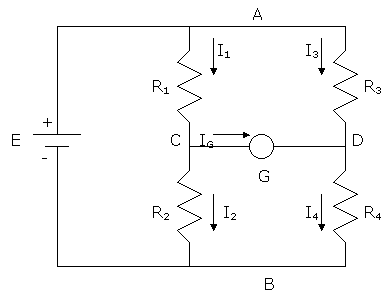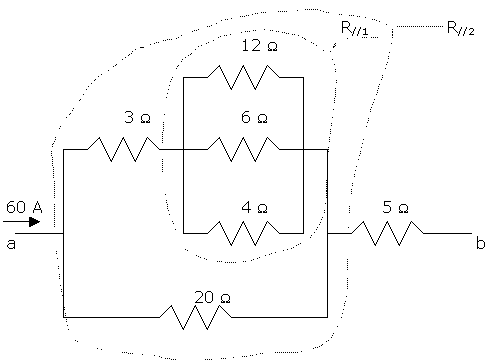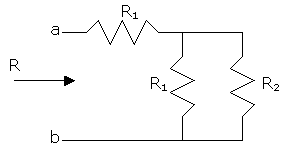Homework Exercises, Ohm's Law,
Example One
The circuit below is called a Wheatstone bridge. It is used for measuring resistance. Show that when the current through the galvanometer G is zero, then R1 = R2(R3/R4). Thus, if we know R2 and the ratio (R3/R4), we can obtain the resistance R1.

IG = 0 means points C and D are at the same potential and
that I1 = I2, I3 = I4.
By Ohmís law VAC = I1R1, VAD = I3R3, VCB = I2R2, VDB = I4R4.
As VAC = VAD and VCB = VDB, then I1R1= I3R3,
![]() I2R2= I4R4.
I2R2= I4R4.
As I1 = I2 and I3 = I4, then doing I1R1/ I2R2=I3R3/I4R4 we get R1= R2(R3/R4).
Homework Exercises, Ohm's Law,
Example Two
Determine the total resistance and potential difference between points a and b in the circuit shown. Also determine the current in, and the potential difference across, each resistor. The input current is 60 A.

a) Total resistance between a and b.
First, calculate the 12, 6, and 4 ohm parallel combination R//1![]() 1/R//1 = 1/12 + 1/6 + 1/4 = 1/2. Then R//1 = 2 ohm.
1/R//1 = 1/12 + 1/6 + 1/4 = 1/2. Then R//1 = 2 ohm.
The upper branch is 3 ohms in series with R//1, 3 ohm + 2 ohm = 5 ohm.
This 5 ohm resistor is in parallel with the 20 ohm resistor, equivalent to a single resistor R//2 = 5 ohm//20 ohm:
![]() 1/R//2 = 1/5 + 1/20 = ľ. Then R//2 = 4.
1/R//2 = 1/5 + 1/20 = ľ. Then R//2 = 4.
The total resistance between a and b is 4 ohm + 5 ohm = 9 ohms. The voltage drop or potential difference between points a and b is 60Ax9ohm = 540 V.
b) To obtain the individual currents and voltages in each resistor we can proceed as follows (there is no a unique method):
The voltage across R//2 is the difference between the total 540 voltage and the voltage drop in the 5 ohm resistor. This drop is 60Ax5ohm = 300 V. So the potential difference across R//2 is 540 V Ė 300 V = 240 V.
Now we can calculate the currents and voltages in the R//2 combination:
In the 20 ohm resistor: current= 240 V/20 ohm = 12 A, voltage = 240 V
The upper branch has then a current of 60 A - 12 A = 48 A, or alternatively 240 V/5 ohm = 48A.
The 3 ohm resistor has a voltage of 48 Ax3 ohm = 144 V.
The R//1 combination presents a voltage of 48 AxR//1 = 48 Ax2 ohm = 96 V, or alternatively 240 V - 144 V = 96 V.
The currents in the 12 ohm, 6 ohm and 4 ohm are respectively 96/12 A=8 A, 96/6=16 A and 96/4=24 A.
Homework Exercises, Ohm's Law,
Example Three
Given the resistor arrangement shown below, prove that the relation between R1 and R2 must be R2=1.618R1 in order that the resistance of the system R be equal to R2.

R=R1+R1//R2=R1+R1R2/(R1+R2).
The condition is R=R2, so we do
R2=R1+R1R2/(R1+R2).
R1R2+R22=R12+R1R2+R1R2.
0= R22 - R1R2 - R12.
This is a second degree equation in R2, whose solution is R2= R1(1/2 Ī ![]() )
)
Disregarding the minus sign we get R2 = 1.618R1.
Related Sites:
· Physics, Main Page
· Physics, Mathematics
· Physics, Detailed Homework Scope Help
· Energy, Work and Power: Concepts
· Kinetic Energy
· Potential Energy
· Power
· Physics Problems, Example
· Physics Homework - Mechanical Energy Conservation Problems
· Physics Homework - Mechanical Power Problems
· Coulomb's Law
· Exercises Using Coulomb's Law
· Electric Field Charges
· Electric Field Exercises
· Electric Potential Energy
· Exercises, Electric Potential Energy
· Gauss' Law
· Gauss' Law Exercises
· Second Newton's Law
· Second Newton's Law Examples, Part One
· Second Newton's Law Examples, Part Two
· Sound Waves
· Sound Waves: Standing, Interference, Doppler Effect - Examples
· Sound Waves, Doppler Effect - Examples
· Vectors, Scalars
· Vectors, Scalars - Analytic Method
· Addition Vector Tools, Problems
· Free Fall Theory
· Free Fall Exercises, Part One
· Free Fall Exercises, Part Two
· Free Fall Exercises, Part Three